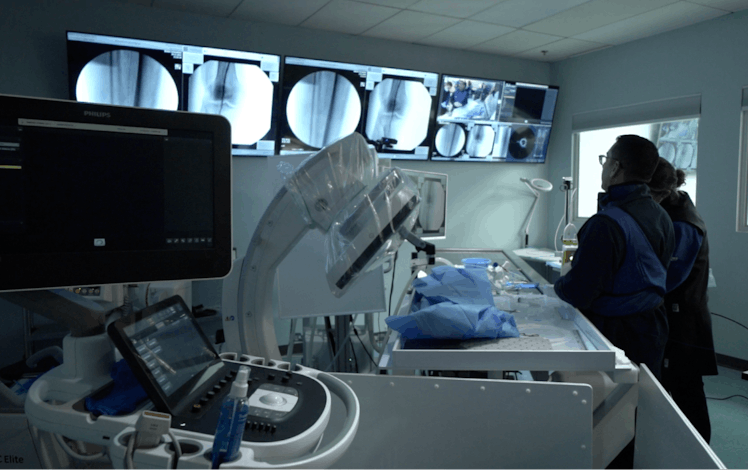Clearing The Path: How One Revolutionary Treatment Is Changing Cardiovascular Care
IVL is the new kid on the block.

Imagine your body as the ultimate performance machine — fine-tuned and ready for adventure. But like any machine getting regular daily use, your body can develop internal roadblocks, like calcific artery disease, where plaque and calcium build up in your arteries and cause a narrowing or blockage of the vessel. It’s a silent threat facing millions worldwide, and it’s on the rise. The good news? FastWave Medical is actively addressing this issue with its game-changing intravascular lithotripsy (IVL) systems, a solution to get and keep clogged arteries wide open.
In the world of interventional cardiology, IVL is the new kid on the block. It’s making waves for its ability to take on the hard, heavily calcified sections — called calcific lesions — where traditional angioplasty treatments, such as stents, balloons, and mechanical atherectomy, often fall short. It’s also relatively easy to learn, meaning more patients in more parts of the country could soon have access to this cutting-edge treatment.
A Breakthrough In Interventional Cardiology
To understand how IVL works, think of a simple garden hose. When the hose is clear, water flows through freely. When it’s clogged up with gunk, flow is constricted. To get your Saturday yard chores back on track, you need to quickly soften or stretch the blockage without accidentally cutting, tearing, or damaging the hose itself. That’s what IVL does for clogged arteries.
First, a doctor makes a small incision in the wrist or groin, threading a thin wire through the incision and into a blood vessel. Using fluoroscopy (imagine a screen with a real-time X-ray image), the doctor navigates the wire forward until it reaches the calcified lesion within a coronary artery that could cause a heart attack. Here’s where it starts to get cool: A tiny balloon containing special emitters is attached to this wire and creates sonic pressure waves.
When the balloon is inflated, it sends out sonic pulses that target and fracture the calcium without damaging the soft artery walls. The result is a vessel that is more open and flexible without the rigid calcium buildup, giving your doctor more options to ensure it stays that way by placing a stent into a fully expandable blockage.
“As patients age and present with complicating diagnoses like diabetes, obesity, and hypertension, treating calcific artery disease has only become more prevalent and more challenging,” says Farouc Jaffer, MD, PhD, an Associate Professor of Medicine at Harvard Medical School and Director of Coronary Intervention at Massachusetts General Hospital. “With IVL, we have a powerful tool that can help us achieve the best possible outcomes and improve the quality of life for our patients.”
Next-Generation IVL From FastWave
With only one other IVL device company in the industry, FastWave Medical’s next-generation IVL technology will surely shake up the developing market. The company’s balloon catheter platforms (remember the thin wires mentioned earlier?) are designed to easily maneuver through complex vascular pathways, enabling doctors to reach and treat areas that are off-limits with the current technology’s shorter, bulkier devices.
FastWave’s new devices are also designed to deliver more pulses than existing systems at a faster rate, reducing the amount of time the heart is under stress. This means physicians using the FastWave technology can tackle longer, tougher lesions without the additional procedure time and cost associated with using a second device.
“Existing IVL technology has unquestionably marked a significant leap forward in our ability to treat calcified arterial lesions, but it also has significant limitations, such as deliverability, pulse count, and balloon durability,” says Amir Kaki, MD, a board-certified interventional cardiologist at Ascension St. John in Detroit. “FastWave’s innovative approach addresses these limitations head-on. I am genuinely excited to see the impact this technology will have on patient outcomes and the future of our practice.”
Accelerating Access To Advanced IVL
IVL has been trending lately with a $13.1 billion acquisition of the aforementioned incumbent’s technology. Consequently and excitingly, FastWave is quickly becoming a frontrunner in the race to revolutionize interventional cardiovascular care. The company has made impressive strides in securing five patents and completing its first study in patients — all within a short timeframe.
But FastWave’s real victory isn’t just in technology or funding — it’s the impact it’s set to have on patient care. By empowering physicians with cutting-edge tools, FastWave is helping them achieve the best possible results for those living with calcified artery disease.
Scott Nelson, co-founder and CEO of FastWave, is optimistic about the company’s next steps. “We're thrilled by the overwhelmingly positive reception to what we’re building and our team’s rapid progression from milestone to milestone. We’ll keep this momentum going to empower as many physicians as possible with advanced IVL technology.”
This article is for informational purposes only and does not substitute for professional medical advice. If you are seeking medical advice, diagnosis or treatment, please consult a medical professional or healthcare provider.
BDG Media newsroom and editorial staff were not involved in the creation of this content.